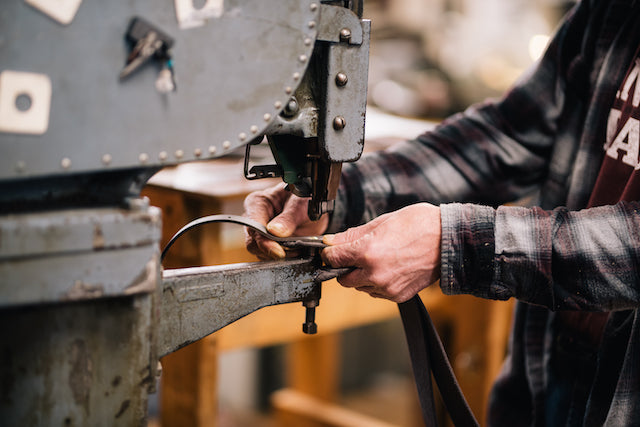Have you ever noticed the brass rivets on your beloved Frost River pack?
You’ve probably noticed the warmth of the brass hardware glittering in the sunshine, but haven’t thought much of it. Did you know that these pieces are some of the most vital, intricate parts of your favorite pack? There are several rivets that go into each pack, all of which have been assembled with steady hands.
There are three types of rivets that are used at Frost River: tubular flare rivets, tubular cap rivets, and hand-pounded rivets. The tubular flare rivets are attached to the pack using a machine that pounds the rivet through a hole in the leather or waxed canvas, then flaring the end of the rivet, locking it into place. This is the most common rivet used in Frost River, with this machine running almost constantly. To install these, the rivet is fed through the machine until it is the next in line to be pressed. A foot pedal is engaged, causing the rivet to be pressed through the hole in the waxed canvas or leather. The rivet then flares at the base, pressing up against the material that keeps it in place.
Frost River Riveting Machine, Photo Credit: Henry Elholm
The next type of rivet is the tubular cap. These slightly shorter rivets are often used for backpack straps and other leather accessories. Much like the tubular flared rivets, these are assembled using a machine. However, instead of the back of the rivet flaring to lock it into place, the tubular cap rivet is pressed into a cap, fusing the two pieces of soft metal together. The installation for the tubular cap is similar to the tubular flare. For this rivet, the riveter needs to make sure the back cap of the rivet is in place on the pressing surface. The riveter then presses a foot pedal that presses the two pieces of metal together, locking the rivet in place.
Frost River Riveting Machine, Photo Credit: Henry Elholm
The third rivet type is the hand-pounded rivet. Like the name suggests, these rivets are hammered into place by hand and are the strongest that Frost River provides. Each rivet has to be pounded, shaped, then pounded again before the final product emerges. The riveter begins with a tapered rivet and a burr. The washer-like burr fits onto the rivet, but only as far as the taper allows. Then, the riveter pounds the rivet into place with a hammer. After that, the excess brass is cut away and the shaping process begins. Using a small, hand-held anvil, the riveter pounds and shapes the rivet until the desired shape is accomplished. With each Isle Royale pack having 19 hand pounded and 12 tubular rivets, this can be a lengthy, tedious process for each individual pack.
Frost River Production Technician hand pounding rivets, Photo Credit: Henry Elholm
Frost River Production Technician hand pounding rivets, Photo Credit: Henry Elholm
Frost River Production Technicians are pounding hundreds of rivets each day. Each one is meticulously placed with a steady hand, ensuring a high quality pack that is built to last. The next time you look at your Frost River pack, make sure to notice and appreciate the beautiful, rugged rivets that help hold the pack together.

